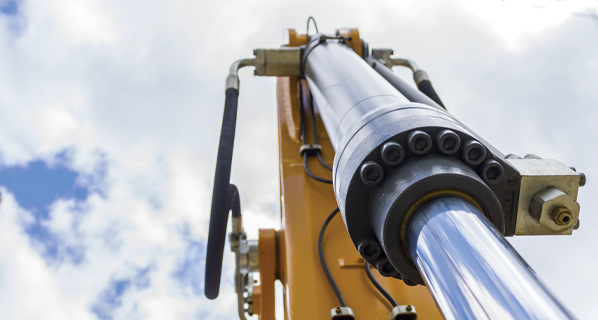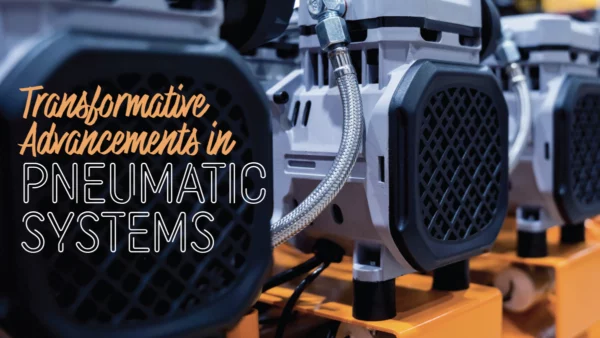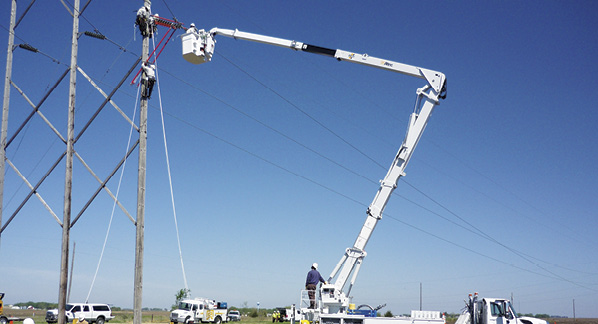2018 Manufacturing Q&A
 Larry Davis, CEO of Daman Products, started the development of Daman’s continuous improvement culture in the fluid power industry over 40 years ago. He has focused on evolving practiced lean manufacturing principles into being a lead promoter of CI in advance manufacturing and marketing concepts.
Larry Davis, CEO of Daman Products, started the development of Daman’s continuous improvement culture in the fluid power industry over 40 years ago. He has focused on evolving practiced lean manufacturing principles into being a lead promoter of CI in advance manufacturing and marketing concepts.
 Frank Langro is currently Director – Product Market Management, Pneumatic Automation, North America at Festo. Frank has represented Festo in multiple areas in support of the advancement of fluid power. Frank, who earned a BS degree in mechanical engineering from Hofstra University, holds four patents in the area of fluid power.
Frank Langro is currently Director – Product Market Management, Pneumatic Automation, North America at Festo. Frank has represented Festo in multiple areas in support of the advancement of fluid power. Frank, who earned a BS degree in mechanical engineering from Hofstra University, holds four patents in the area of fluid power.
 Tim Twitty is the Director of Global Manufacturing Systems for HydraForce, a provider of hydraulic cartridge valves and custom hydraulic system manifolds for the mobile and industrial equipment markets. He focuses on strategic manufacturing business solutions in automation and robotics to meet the mission and vision of HydraForce.
Tim Twitty is the Director of Global Manufacturing Systems for HydraForce, a provider of hydraulic cartridge valves and custom hydraulic system manifolds for the mobile and industrial equipment markets. He focuses on strategic manufacturing business solutions in automation and robotics to meet the mission and vision of HydraForce.
 Mohaned Shahin, CFPS, is an Account Manager at Parker Hannifin. He has been in the Fluid Power Industry for 4 years with a primary focus in the Industrial Automotive Market. He also sits on the Board of Directors of the Fluid Power Society.
Mohaned Shahin, CFPS, is an Account Manager at Parker Hannifin. He has been in the Fluid Power Industry for 4 years with a primary focus in the Industrial Automotive Market. He also sits on the Board of Directors of the Fluid Power Society.
Are manufacturers poised for growth in the next 6-12 months? Why or why not?
Larry Davis: We continue to see growth coming from various industrial sectors. Since potential rising material costs would equally impact everyone, manufacturing in the USA will grow stronger, as long as we keep innovating and developing a workforce to fill the much-needed production jobs in the USA. Right now, and in the foreseeable future, workforce shortage is our greatest challenge. Markets are accelerating beyond our capacity to hire and train people. A hidden cost to consider is the time that our experienced workforce must set aside to train new people. The inaccessibility of skilled people will continue to infringe on our ability to meet customer demand.
Frank Langro: I believe that we will continue to see good growth in the manufacturing sector in 2018. The corporate tax breaks will spur re-investment to meet the consumer demand for products. The strength of the rebound of 2017 caught many companies off guard and supply chain issues were visible globally. This seems to be somewhat under control now. I think the leading suppliers are poised to meet the demands of the OEMs and end users.
Tim Twitty: The global manufacturers’ PMI index has been strong through the first quarter of 2018. Since the economic slump nearly a decade ago, manufacturers have been firming up their foundations, making technological investments, and accelerating associate training, all leading to increases in the ability to ship products (globally). Manufacturers have also accelerated investments in automation which has been a significant contributor to meeting demand. So, yes, manufacturers continue to position themselves for growth from a short- and long-term perspective.
Mohaned Shahin: The manufacturing industry is experiencing a sustained period of growth, and we have seen broad-based improvement in key economic indexes across end markets and regions. We expect this positive backdrop to continue for the next several quarters. At Parker, these improved market conditions, together with the ongoing benefits of implementing the new Win Strategy™, continue to deliver widespread improvements across our company, and we are anticipating a record year in fiscal 2018.
How has the Internet of Things (IOT) impacted the state of manufacturing? Is this a positive or negative development?
Larry Davis: Obviously, the internet continues to increase the speed by which information is shared. Yet, IOT is not fully understood by most manufacturing. Thus, its impact will be evolving in the next five or so years. Now, it is mostly useful and productive in further developing relationships with customers and acquiring product and market information. The ability to decipher what are practical IOT applications and how they will be best adopted by people staging the processes will continue to be where the rubber meets the road.
Frank Langro: Many companies are still in the initial stages of Industrial Internet of Things (IIoT) implementation as they consider how to collect and analyze the data available to them. But the impact on industry is becoming apparent in some of the trends we see. For instance, IIoT has spurred growth in technologies such as IO-Link because of its ability to transmit field data at low installation cost. We have also seen automation component manufacturers adding more intelligence to products and developing devices (or gateways) to aggregate key data to transmit to servers (or clouds) for further analytics or actions. IIoT is an area where Festo is looking to develop solutions, and one of our first targets is in predictive maintenance and failure detection. These positive developments are helping production plants be more efficient and competitive in the global marketplace.
Tim Twitty: The IoT has already had a significant impact on manufacturing. Manufacturers that have strategically implemented technology, or, as it is now called, the IoT or Industry 4.0, have reaped the benefits for years—there just wasn’t a name associated with it then. It improves the entire manufacturing flow and process, making strong manufacturers stronger by identifying constraints where improvements can be made and allowing one to see areas where you are excelling, allowing you to capitalize on what you do best. These benefits have been across the entire value chain from manufacturers to suppliers to customers and all operational activity in between. Successful manufacturers are moving away from silos of unconnected operations, activity and data. This change is creating a nexus in manufacturing that benefits all partners in the chain, allowing for better identification of constraints and issues. Companies who are looking to be more efficient and productive, those willing to adopt the IoT practices, will be better positioned to deal with whatever changes they face. So, from my perspective it is a positive.
Mohaned Shahin: Technology fueling the Internet of Things continues to advance at a rapid pace, and we’re excited about the future potential of connected smart products and systems to help us better serve our customers and improve their operations. By bridging the gap between digital and physical worlds, IoT is enabling new levels of efficiency and growth by giving industrial companies a clear line of sight into critical asset and manufacturing processes. What previously required cumbersome procedures can now be accomplished with cloud-based solutions, like our own Voice of The Machine platform.

How is the current global economy affecting manufacturing in terms of technological innovation?
Larry Davis: The combination of a global economy and technological innovation is now the norm. The competitive space has expanded over recent decades, not months, and will only continue to do so. We have to assume that just about every product can be made anywhere — or at least certainly any product’s major components. We look at all of these global innovation considerations as a natural condition that needs to be assessed just as any other competitive evaluation.
Frank Langro: The growing global economy is pushing manufacturers to increase their productivity. One of the drivers is the expanding middle class, which is opening new markets, primarily in Asia. For example, sales of electronic products, such as smartphones, tablets, GPS devices, and portable fitness devices, are increasing at high rates. Competition shortens product lifecycles. Manufacturers must embrace new methods and technology to become more productive.
Tim Twitty: In short it is allowing us to deliver a better product and experience to our customers. We have all experienced how Information Technology (IT) has changed our everyday lives through connectivity. This technology has been an enabler for manufacturers by allowing them to respond more rapidly to customer requests, to increase efficiencies in business operations and to communicate globally. Today’s intelligent machines and systems, along with this connectivity, have had a significant impact on communications throughout the value chain. Examples of these advancements come from tools such as Electronic Data Exchange (EDI) enhancing how customers place orders to manufacturers that is more efficient and reliable to digital KanBan systems used in manufacturing linked to suppliers, enabling manufacturers again to lower inventories, reduce cost and meet customers requests globally.
Mohaned Shahin: The global economy continues to have a positive effect on the quality and speed of manufacturing innovation. Given the scope of Parker’s operations, it is important that our R&D efforts are targeted towards a global customer base–the economy’s strong momentum supports our ability to do that. For example, Parker has recently opened a new advanced manufacturing learning and development center, and the investment will enable us to leverage innovative technologies, including additive manufacturing and robotics to better solve our customers’ challenges.
What leadership strategies will help manufacturers remain competitive in the future?
Larry Davis: We are currently experiencing the manufacturing skill shortage predicted 40 years ago. Only to be exacerbated by the deafening drumbeat that “manufacturing is not for my kid.” Automation will help. However, only when labor wages jump to be in the $40-$50 per hour range, will people actively start to move toward manufacturing positions. Until then, developing people is number one. Nationally, we have a long stretch ahead of us where we will compete to gain and train the best people in order to maintain a limited skilled workforce. The leadership teams that provide a culture where people can grow and develop will be the ones that win in the future. The true golden ticket for success is to additionally develop people to connect more effectively with customers, understand their needs, and efficiently build products and services aligned with customers’ goals—and that task is one that will continue to be a challenge to master.
Frank Langro: Leaders must give their teams the tools to lower scrap and unplanned downtime. In collaboration with their prime OEMs and supply chain partners, brands must move toward a future where they can retool or reconfigure a machine to produce the next generation devices as quickly as possible. Today it is no longer the norm to have dedicated production lines to produce high volumes of the same item year after year. Manufacturers must be able to reconfigure their equipment to produce smaller lot sizes at high volume. IIoT concepts like predictive maintenance, production line monitoring, and fast reconfiguration of tools become necessary for companies to remain competitive.
Tim Twitty: Leaders need to be great strategist, to understand and communicate why their organization matters. Communication is always key and manufacturing leaders who can articulate why their products are important, how they are differentiated in the market, and how operational excellence is key to satisfying customers will be an effective, successful leader and remain competitive. Leaders from different functions within the organization need to align their activity around the business strategy that has a clear focus on customers. Also, a leader needs to surround themselves with creative and non-traditional thinking associates who can respectfully challenge the status quo which may be a constraint in their operations today.
Mohaned Shahin: We believe that attracting and retaining top talent is the most effective way to ensure competitiveness in an increasingly crowded market. One of our highest priorities is engagement, and finding new ways to enable our team members to leverage their expertise to improve the company’s performance. It’s also critical that we continuously re-evaluate our strategy based on the rapidly evolving needs of customers. Our customers are facing more complex challenges than ever before, so it’s important that we offer tailored solutions that help our customers to improve operations and their bottom line.







